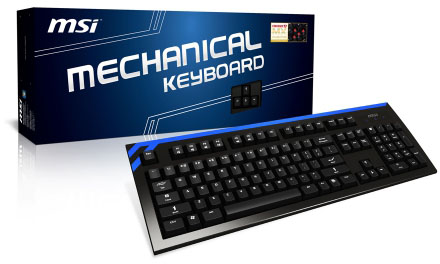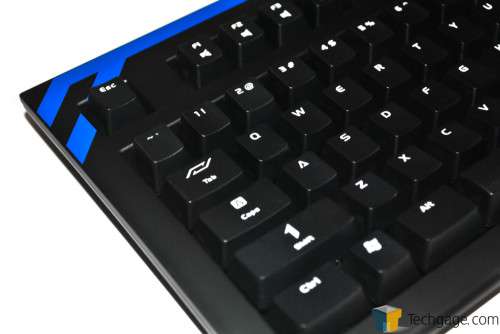- Qualcomm Launches Snapdragon 4 Gen 2 Mobile Platform
- AMD Launches Ryzen PRO 7000 Series Mobile & Desktop Platform
- Intel Launches Sleek Single-Slot Arc Pro A60 Workstation Graphics Card
- NVIDIA Announces Latest Ada Lovelace Additions: GeForce RTX 4060 Ti & RTX 4060
- Maxon Redshift With AMD Radeon GPU Rendering Support Now Available
MSI CK Series Mechanical Keyboard Review

Following a template established by two of its greatest rivals, MSI has joined ASUS and GIGABYTE in the PC peripherals market with its CK Series mechanical keyboard. Like GIGABYTE’s Osmium, it features Cherry MX Red switches. Unlike the Osmium, it’s priced to move at $69.99. But what’s it like to live with one? Let’s find out.
Page 2 – Testing and Final Thoughts
Evaluating such a straightforward and fairly basic keyboard as the CK Series should be a straightforward and basic process. It doesn’t come with a bespoke software package you need to install; indeed, in terms of functionality the only “extra” worth the name is the fact that it has multimedia shortcut keys. Consequently, this section of the review will concentrate mainly on describing the end user’s experience.
First off, some comments on the CK Series’ build quality.
Applying my de rigueur chassis flex test reveals that the CK Series’ body exhibits a little bit of flex. It’s a minimal degree of flexion, but it’s visually noticeable. You never get the impression that you can literally twist this thing to utter destruction (unless you are freakishly strong, of course), but compared to most of this product’s competitors that I have already tested this is a little bit out of the norm. The GIGABYTE Aivia Osmium, for example, feels as robust as Darth Vader’s Super Star Destroyer. Even Cooler Master’s various QuickFire keyboards feel indestructible.
The key caps, of course, are removable by design (an easy job with the supplied key cap puller). However, the key caps seem to be made out of plastic that feels somewhat brittle compared to what I’m accustomed to seeing. I can squeeze the edges of the key cap and see it deform somewhat between my fingers. Again, compared to its competitors, the CK Series suffers a little bit. Most of the planks I’ve reviewed, not to mention my daily driver keyboard, feel like they use higher quality plastic for their key caps. Having said that, the material seems strong enough to survive normal usage patterns. However, I certainly wouldn’t do anything extreme, like one of MSI’s competitors did, to test out this product’s ultimate survivability.
Another comment about the key caps: A couple of them shook loose during shipment to me, including the left-side Shift, Caps Lock, and Alt keys. I wish I had the presence of mind to have photographed that, but I didn’t. Bad job on my part. Don’t be alarmed if something similar happens to your CK Series; just be aware that it could happen. I honestly cannot recall something like this happening to another keyboard I’ve reviewed.
On the plus side, the key caps have a pleasant texture to them. I’ve tested at least one keyboard which had ridiculously slippery key caps; I simply abhor that slippery feeling when it comes to the surface treatment of computer peripherals. Thankfully, MSI equipped its CK Series with key caps that have a delightfully appropriate level of coarseness to them. These key caps are on a par with the very best ones I’ve had the pleasure of using.
Moving on to functionality now, the CK Series just plain works. I tested its one trick feature, the media shortcut keys, and discovered that it works superbly at manipulating the audio volume. You can mute the sound and adjust the volume either way just by simultaneously pressing the Fn key and the corresponding F-key (F1-F3). However, Play/Pause (F4), Previous Track (F5), and Next Track (F6) only work on Windows Media Player and, funnily enough, iTunes. I use other programs for media playback (Winamp for music, VLC and PowerDVD 12 Ultra for movies), and I can’t use the CK Series’ playback media shortcuts on these, unfortunately.
I’ve consistently opined on several occasions that Cherry MX Red switches aren’t ideal for typing, which certainly reflects my own personal experience. I type fastest on Cherry MX Blues, while being slightly slower on Browns and Greens. At my very best, I can do about 92WPM/0 errors on my Cherry MX Blue-equiped daily driver keyboard. In comparison, I could only do a consistent 78WPM/1 error average performance on the CK Series. When I pushed myself to go faster, I consistently did 85WPM/5 errors. I must emphasize that this is not a reflection on the quality of the keyboard at all. This is purely down to the Cherry MX Red switch type. Reds are so light (45g) and possess no tactile feedback whatsoever; consequently, it’s so very easy to register “false” key presses. These false presses result in either typing more of the correct character or inadvertently pressing an incorrect key altogether.
For gaming, though, Reds are an absolute joy. They are very light and responsive. Double taps and multiple key presses are no problem (not that I think they are with my Blues, to be honest). No matter what game, no matter what genre, the CK Series was a fine companion. I have absolutely zero complaints about this plank when it comes to using it for gaming.

Ergonomically speaking, I found this keyboard to be slightly unusual. You see, with all the other keyboards I’ve used, I have them set up so that they’re completely flat. In other words, I never felt the need to use the keyboard’s feet to elevate its rear end. The CK series is the very first keyboard where I felt it was absolutely necessary to raise its backside just to be comfortable using it. With it flat, it felt… wrong. It felt weird. For one thing, I felt like I needed to stretch my fingers more than usual to reach keys two rows above home row. It felt so unfamiliar that I found my hands hurting after just a few minutes’ use. Elevating the rear made things considerably better, completely alleviating my discomfort. I felt no more pain after using the keyboard’s feet.
I took a closer look at the CK Series and compared it to my everyday plank. I was quite a bit surprised to discover that the keys on the front of the CK Series were noticeably higher in elevation compared to what I’m used to. This resulted in a hand position that felt unnatural to me.
It may be that other end users would never experience what I did. I certainly hope so. However, as a reviewer I feel obligated to note every single observation, whether positive or negative, and report it to our readers.
So, what’s the bottom line regarding MSI’s CK Series keyboard? I think the answer to this depends entirely on how you perceive this product. MSI has priced this at $69.99, which makes it one of the most affordable full-sized Cherry MX-equipped keyboards around. Mind you, that is its full price, not a sale price. With this in mind, I think it’s appropriate to view it as an entry-level product. It’s as basic as keyboards get, yes, except that it has the advantage of being equipped with Cherry MX switches. This is a big deal, since mechanical key switches are superior in every way (except, perhaps, cost) to non-mechanical switches. But, yes, the CK Series should never be mistaken for a top-of-the-line product. Except for its media key shortcuts, functionality is pretty standard. The inclusion of four extra key caps and a key cap puller is a concession to consumers who may want the option to dress up their keyboard in some way.
My comments on its construction and the apparent quality of the materials only reinforce the idea that the CK Series is an entry-level mechanical keyboard. However, I have no reservations at all to declare that, compared to even the most expensive membrane-switch keyboards, this is a high-quality product. It only really suffers in comparison to some of its peers, and only if you were really picking the smallest nits. Indeed, compared to some specific competitors, you do get more for your money than even comparably-priced rivals (and these rivals only approach the CK Series in price when they go on sale). I’m talking specifically about competitor models that don’t have a 10-key number pad here.
The ergonomic issue I encountered may be something that’s specific only to me, but even that is possibly a result of just being intimately familiar to my own personal equipment. In other words, if this was my very first mechanical keyboard, it’s very likely I wouldn’t have experienced the issue I noted. It’s easier to adjust to something completely new; you don’t have prior experience with which to compare it. Your muscle memory doesn’t have to unlearn anything, you know? Consequently, I’m not docking it any negative points, especially since the solution is built-in.
In conclusion, I think MSI’s CK Series is a lot like a classic British sports car such as an MG, albeit one that is properly sorted. Sure, it might not be built like a luxury SUV, and it may not have a lot of extras included. But it just plain works. Its idiosyncrasies lend it a certain degree of character and a whole lot of charm. The no-frills experience of using it day-to-day is reason enough to own one. And the pricing is also perfect for what it is and for everything it promises.
Sometimes the most basic and simplest solutions really work the best.

MSI CK Series Mechanical Keyboard
Support our efforts! With ad revenue at an all-time low for written websites, we're relying more than ever on reader support to help us continue putting so much effort into this type of content. You can support us by becoming a Patron, or by using our Amazon shopping affiliate links listed through our articles. Thanks for your support!






